|
Goodyear
Tire and Rubber Company
in World War Two
Akron, OH
1898-Current
This page updated 5-28-2023.
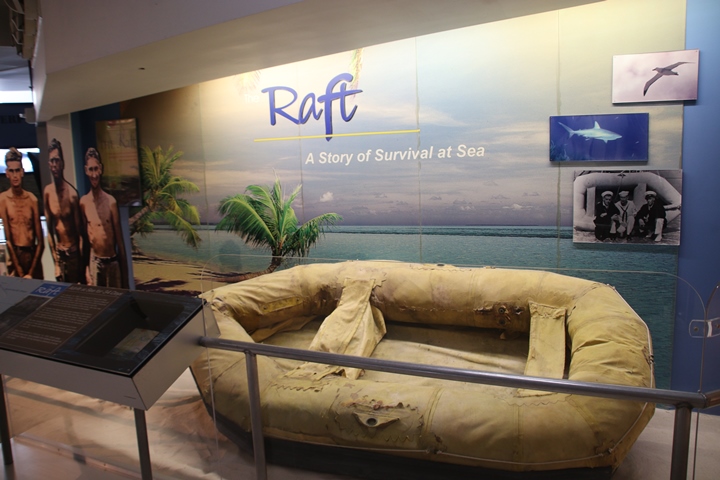
This display at the National Aviation Museum is titled:
Raft - A Story of Survival at Sea
This could also read:
A Goodyear Raft - How it Saved The Lives of Three Naval Aviators
The center piece of this
display at the museum is the raft that the three naval aviators spent 34
days on in the Pacific Ocean. This raft was produced by the
Goodyear Tire and Rubber Company. Author's photo added 5-28-2023.
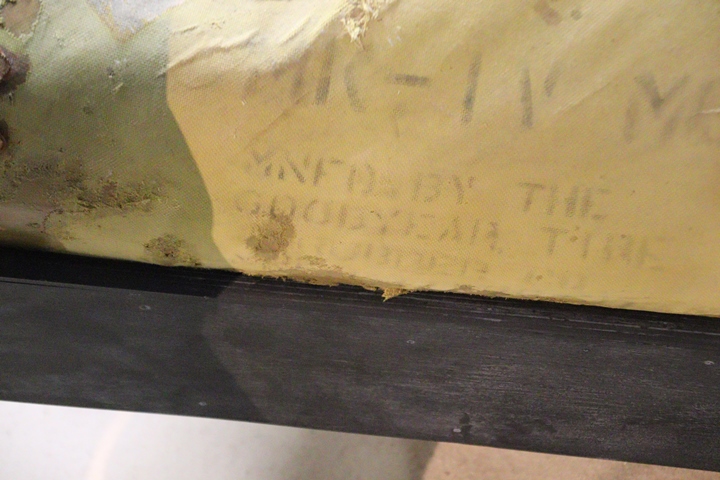
Author's photo added 5-28-2023.
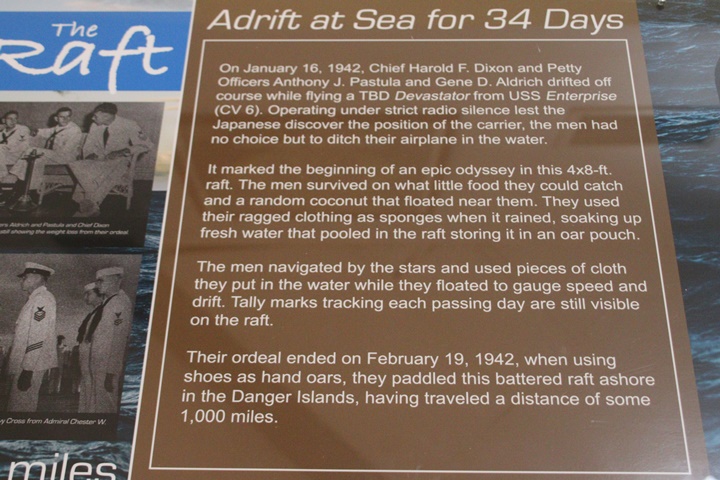
Author's photo added 5-28-2023.
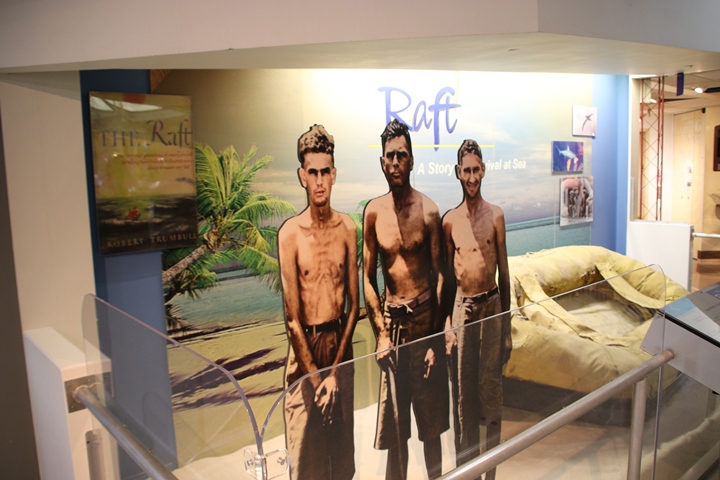
Author's photo added 5-28-2023.
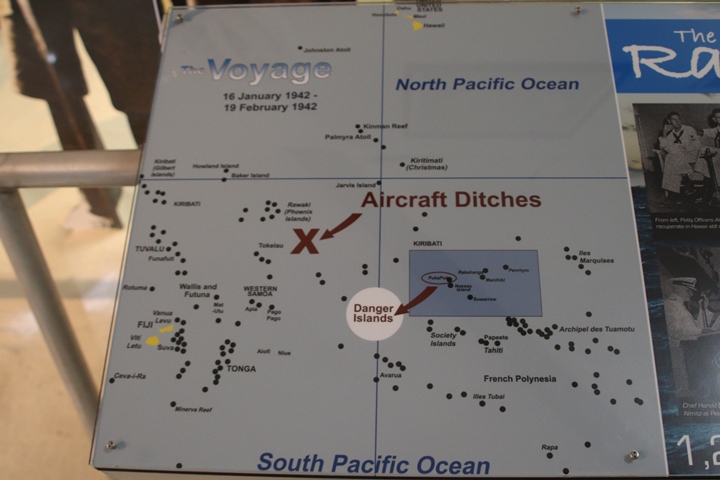
Author's photo added 5-28-2023.
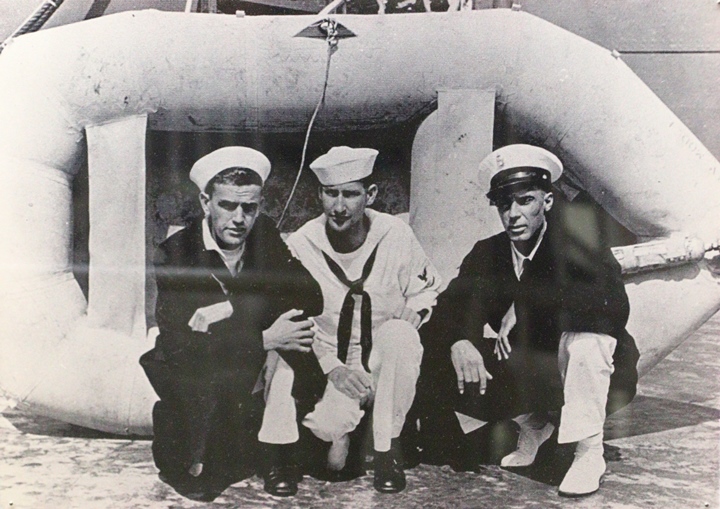
Photo added 5-28-2023.
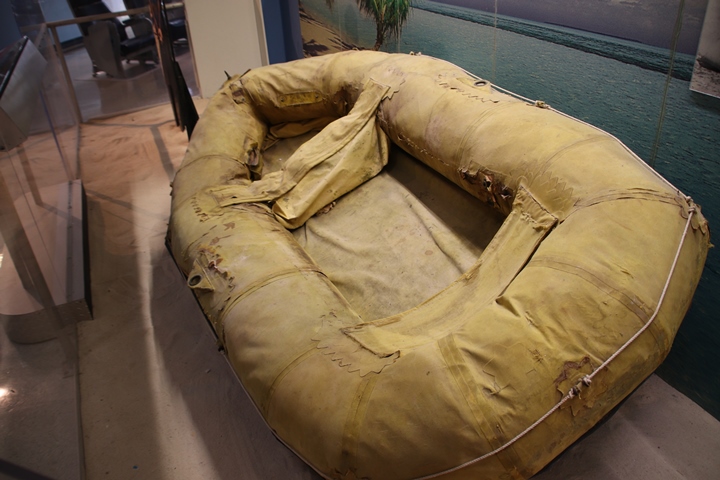
This raft is a testament to the
quality of the work by the Goodyear workers that produced this raft
which saved the lives of three naval aviators. Goodyear did more
than just help win World War Two, it also saved lives with the rafts it
produced. Author's photo added 5-28-2023.
Goodyear Tire and Rubber (Goodyear) was formed
in 1898 in Akron, OH by Frank Seiberling to produce bicycle and carriage
wheels. The company then grew into the automotive tire business
for which it is best
known. The company could have been known worldwide as Seiberling Tire and Rubber if Mr. Seiberling
hadn't decided to name the company after Charles Goodyear, who invented
vulcanized rubber. Currently, Goodyear is a multinational company
and is the only American company still in the top four tire companies in
volume. During World War Two Goodyear was 30th in the production
of war products in the United States. While the company is best
known for its tires and rubber products, during World War Two the
company produced a variety of products at multiple locations as noted in Table 1 below.

The
Goodyear Decatur Mills, AL plant won the Army-Navy "E" award three times
during World War Two.
The
Goodyear Gadsden, AL plant won the Army-Navy "E" award one time during
World War Two.
The
Goodyear Clearwater Mills plant #1, Cedartown, GA, won the Army-Navy "E"
award two times during World War Two.
The
Goodyear Clearwater Mills #2, Rockmart, GA won the Army-Navy "E" award
two times during World War Two.
The Goodyear Clearwater Mills #3, Cartersville, GA won the Army-Navy "E"
award two times during World War Two.
The
Goodyear Engineering Corporation, Hoosier Ordnance Plant, Charlestown,
IN won the Army-Navy "E" award five times during World War Two.
The
Goodyear Aircraft Corporation, Akron Plant won the Army-Navy "E" award
one time during World War Two. This included the Millersburg, Newark,
and Uhrichsville, OH plants.
The
Goodyear Tire and Rubber Plant #3, Akron, OH won the Army-Navy "E"
award one time during World War Two.
Goodyear Tire and Rubber World War Two
Products: The Goodyear wartime products were very diverse and
manufactured in the company's many plants located in various parts of
the United States. This information has been captured in Table 1.
Table 2 shows the company's production of airships, or blimps, during the
war. Table 3 shows the number of tracks the company made for the
half-track.
Table 1 - Goodyear World War Two Products by Plant
The information provided in this table is from,
"Authorizations of War
Industrial Facilities Financed with Public and Private Funds,
June 1940 - July 1945" by the Civilian Production
Administration.
This document provides the most comprehensive coverage of
Goodyear's contribution to winning World War Two that is
available, as there is not much else in the way of documentation
available on what the company did during the war. That
being said, some of the entries are not quite descriptive enough
to identify the product. But in most cases, this is an
excellent view of what Goodyear's many plants contributed to the
war effort. |
|
Plant |
Location |
Product |
Comments |
|
Goodyear Tire and Rubber Company |
Akron, OH |
Aircraft nose and tail wheels, aircraft brakes, barrage
balloons, half-track tracks, combat tire rims, 20-1/2 x 6-1/4
road wheels, 22 x 6-1/4 idle wheels, gun carriage tracks,
synthetic rubber softeners, bullet sealing fuel tanks,
rubberized fabrics, plastic containers, reclaimed rubber, tires
and tubes, bullet seal hose, hydraulic brake hose, aircraft fuel
oil and coolant hose, gas masks, agricultural V-belts, steel
cable V-belts, earth mover tires, large rubber landing craft,
electric power transmission |
|
|
Goodyear Tire and Rubber Company - Goodyear Aircraft Corporation |
Akron, OH |
FG-1,
F2G, airships, B-26 outer wings, B-29 fuselages and empennage
assemblies, P-61 outer wings and empennage assemblies, aircraft
wheels, aircraft brakes, assemblies for B-33, TBF, P-38 control
surfaces, control surfaces for F6F, F3 |
The
B-33 is assumed to be the Convair B-32 Dominator. The F3
is unknown. |
|
Goodyear Tire and Rubber Company - Goodyear Aircraft Corporation |
Litchfield Park, AZ |
PB4Y
wing panels, control surfaces, and empennages, PB2Y flight
decks, non-rigid aircraft |
|
|
Goodyear Farms |
Litchfield Park, AZ |
Pre-Fabricated Buildings |
|
|
Goodyear Tire and Rubber Company - Goodyear Clearwater Mills |
Atco,
GA |
Plied
yarns, army duck canvas, and tire cord |
|
|
Goodyear Tire and Rubber Company - Goodyear Decatur Mills |
Decatur, AL |
Plied
yarns and Rayon tire fabric |
|
|
Goodyear Tire and Rubber Company - Goodyear Engineering
Corporation, Hoosier Ordnance Plant |
Charlestown, IN |
75mm,
105mm, 155mm, M1A1 155mm, 1MZ 155mm howitzer charges |
|
|
Goodyear Tire and Rubber Company - Goodyear Fabric Corporation |
New
Bedford, MA |
Barrage balloons, life rafts, self-sealing aircraft fuel and oil
cells |
|
|
Goodyear Tire and Rubber Company - Goodyear Fabric Corporation |
Woonsocket, RI |
Pneumatic water targets |
|
|
Goodyear Tire and Rubber Company - Goodyear Michigan Corporation
|
Jackson, MI |
Three-inch anti-tank guns |
|
|
Goodyear Tire and Rubber Company - Goodyear Synthetic Rubber
Corporation |
Akron, OH |
Copolymer type synthetic rubber |
|
|
Goodyear Tire and Rubber Company - Goodyear Synthetic Rubber
Corporation |
Houston, TX |
Copolymer type synthetic rubber |
|
|
Goodyear Tire and Rubber Company - Goodyear Synthetic Rubber
Corporation |
Los
Angeles, CA |
Six
and twelve-ton pontoons, copolymer type synthetic rubber,
aircraft fuel and oil cells, rubber dipped fabric, gas mask nose
cups and face pieces, truck and aircraft tires |
|
|
Goodyear Tire and Rubber Company - Goodyear Tennessee
Corporation |
Nashville, TN |
Heavy
duty military tires |
|
|
Goodyear Tire and Rubber Company |
Des
Moines, IA |
Self-sealing fuel tanks |
|
|
Goodyear Tire and Rubber Company
|
Detroit, MI |
Rubber tires, tanks, rafts, belting,
etc. |
|
|
Goodyear Tire and Rubber Company |
Kokomo, IN |
Beadlock bands for the heavy truck program |
|
|
Goodyear Tire and Rubber Company |
Lincoln, NE |
Self-sealing fuel and oil cells, tires, mixed rubber stock |
|
|
Goodyear Tire and Rubber Company |
Muncie, IN |
Combat tank tracks, Boeing motor parts |
|
|
Goodyear Tire and Rubber Company |
Natrium, WV |
Vinylidene and chloride copolymer. diethyl maleate copolymer |
|
|
Goodyear Tire and Rubber Company |
New
Bedford, MA |
Fuel
cells, tires |
|
|
Goodyear Tire and Rubber Company |
Saint
Marys, OH |
Bushings for tank blocks, tank assembly blocks, tank shoes,
hydraulic aircraft blade???, aircraft motor mounts, pliofilm |
|
|
Goodyear Tire and Rubber Company |
Suffield, OH |
Aircraft surface parts, wheels, brakes, etc. |
|
|
Goodyear Tire and Rubber Company |
Topeka, KS |
Military tires |
|
|
Goodyear Tire and Rubber Company |
Woonsocket, RI |
Rubber targets |
|
|
Goodyear Tire and Rubber Company - Goodyear Tire and Rubber
Company of Alabama |
Gadsden, AL |
Dispersite, self-sealing fuel tanks, non-combatant gas masks,
truck tires, rubber dipped fabrics, reclaimed and synthetic
fiber |
|
|
Goodyear Tire and Rubber Company - Goodyear Tire and
Rubber Company of Michigan |
Jackson, MI |
Self-sealing fuel tanks, tires and tubes |
|
|
Goodyear Tire and Rubber Company- Kelly Springfield Tire Company |
Cumberland, MD |
Ammunition, 50 cal,
Shells - 8 inch M106 H.E.,
Tires and tubes, automotive
Tires and tubes, bus and truck |
|
|
Goodyear Tire and Rubber Company - Kelly Springfield Tire
Company |
Houston, TX |
Heavy
duty military tires |
|
|
Goodyear Tire and Rubber Company - Goodyear Yellow Pine Company |
Picayune, MS |
Creosote lumber piling |
|
|
Table 2 - Goodyear Deliveries of Airships World War Two |
| Type |
1941 |
1942 |
1943 |
1944 |
1945 |
Total |
| K |
4 |
20 |
92 |
17 |
0 |
133 |
| L |
2 |
9 |
10 |
0 |
0 |
19 |
| G |
0 |
0 |
6 |
1 |
0 |
7 |
| M |
0 |
0 |
1 |
3 |
0 |
4 |
| Total |
6 |
29 |
109 |
21 |
0 |
163 |
|
Table 3 -
Goodyear World
War Two Half-Track Tracks
Accepted by Detroit Ordnance, US Army
The information below comes from "Summary Report of
Acceptances, Tank-Automotive Material, 1940-1945."
Published by Army Services Forces, Office, Chief of
Ordnance-Detroit, Production Division, Requirements and
Progress Branch
January 21, 1946. |
|
Type |
Same as |
1940 |
1941 |
1942 |
1943 |
1944 |
1945 |
Total |
| Tracks, 12-inch,
58 pitch band |
B.F. Goodrich,
Firestone |
|
44 |
4,000 |
11,160.5 |
10,820 |
5,626.5 |
31,651 |
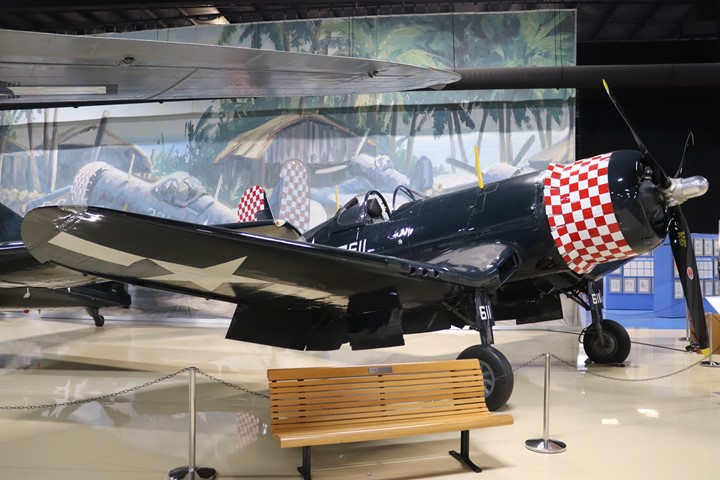
The most recognizable and well-known of Goodyear's World War Two
products was the FG-1 Corsair, a licensed copy of the Vought F4U
Corsair. Goodyear built 4,007 of these famous
fighters in Akron, OH. This example is on display that the
Kalamazoo Air Zoo Aviation Museum. Author's photo.
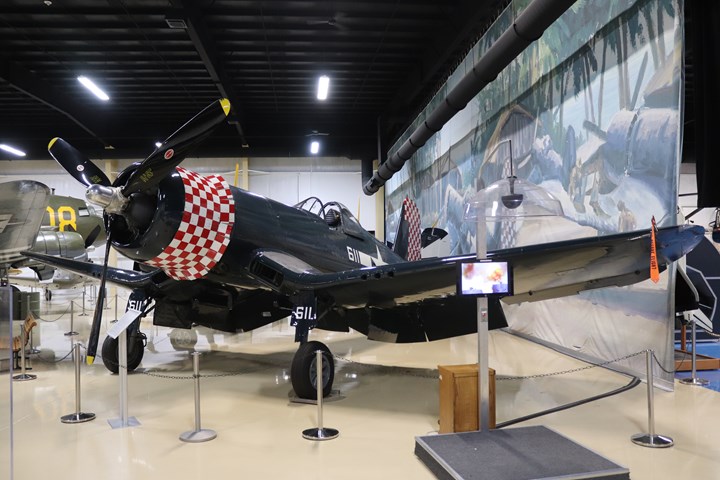
This is Goodyear construction number 3770.
Author's photo.
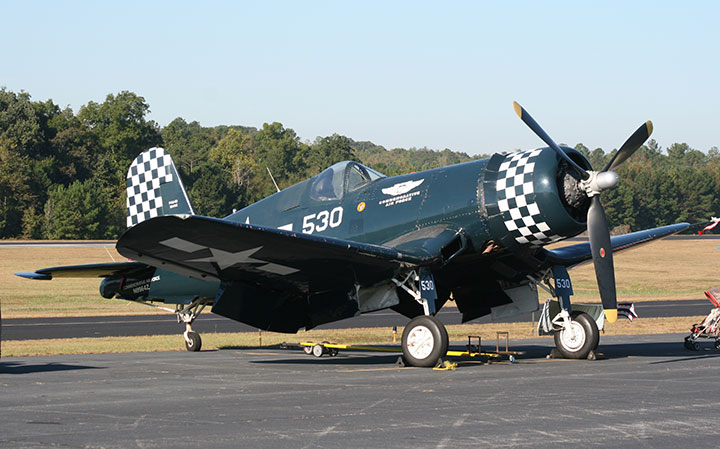
Goodyear built 4,001 FG-1s during
World War Two. During 1944 it produced its 3,000th of these aircraft,
like this FG-1 owned by the Commemorative Air Force. Author's
photo.
|
Table4 - Goodyear World War Two FG-1 U.S. Navy
Monthly Acceptances
This table added 9-28-2022. |
|
Month |
Number Accepted |
| 1943 |
|
| April |
2 |
| May |
7 |
| June |
16 |
| July |
22 |
|
August |
30 |
|
September |
77 |
|
October |
63 |
|
November |
78 |
|
December |
82 |
|
1943 Total |
377 |
| |
|
|
1944 |
|
|
January |
150 |
|
February |
147 |
| March |
222 |
| April |
220 |
| May |
220 |
| June |
160 |
| July |
170 |
|
August |
168 |
|
September |
180 |
|
October |
182 |
|
November |
145 |
|
December |
144 |
|
1944 Total |
2,108 |
| |
|
|
1945 |
|
|
January |
103 |
|
February |
178 |
| March |
262 |
| April |
205 |
| May |
195 |
| June |
179 |
| July |
180 |
|
August |
151 |
|
1945 Total |
1,453 |
|
September |
68 |
|
Grand Total |
1,521 |
Goodyear also manufactured eight F2Gs.
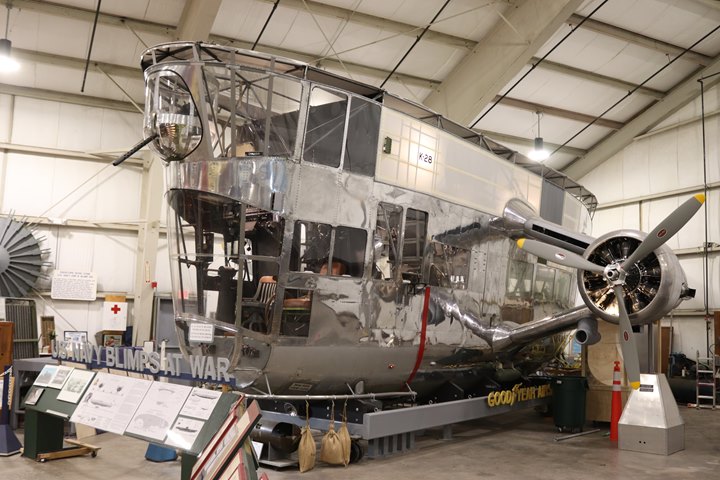
The most unique product that Goodyear built
for the war effort was the airship for the U.S. Navy. It was
the only company to build airships during the war effort. The United
States was the only country to operate airships during World War Two. This fully restored crew
cabin from K-28 is on display at the New England Air Museum.
Author's photo.
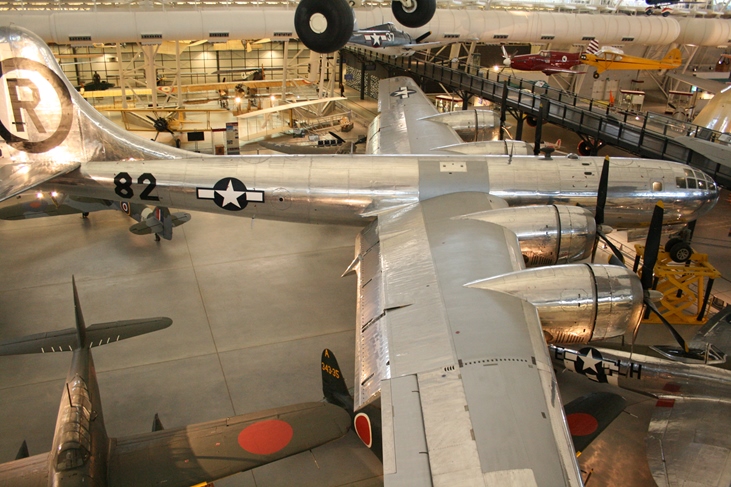
The most significant, yet unknown, Goodyear
World War Two products were the forward and rear bomb bay fuselage
sections that Goodyear built for the B-29 Enola Gay. Goodyear also
supplied the rudder, vertical stabilizer, dorsal fin assembly, elevator
assembly, and horizontal stabilizer assembly for the Enola Gay.
These components were built at the same facility as the
FG-1 Corsairs at the Akron Airport in Akron, OH, and for 530 other B-29s as
well. Author's photo.
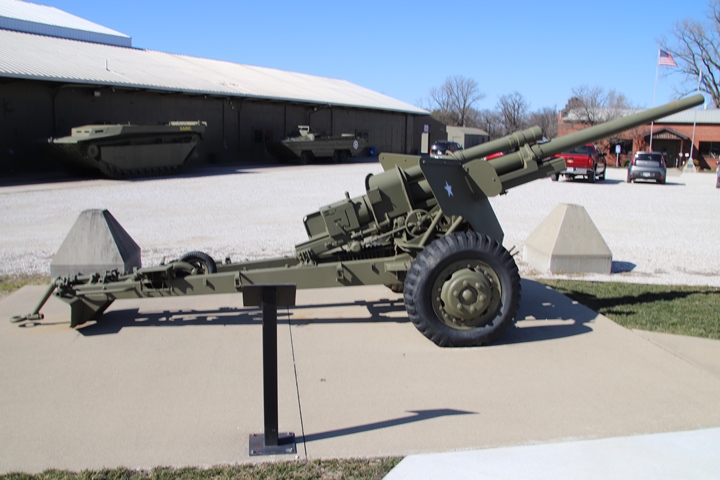
The most unusual weapon was the M5 three-inch
anti-tank gun made by the Goodyear Michigan Corporation in Jackson, MI.
It is unusual because one does not normally think of a tire and rubber
company making weapons of this size. Pullman-Standard built the
carriage for this particular M5 that is on display at the Indiana
Military Museum in Vincennes, IN. There is no identification as to
which company or arsenal built the barrel and recoil assemblies.
Normally, the Rock Island Arsenal built recoil assemblies for
weapons of this type, and the Watervliet Arsenal built the barrels.
However, an entry in Table 1 identifies the Goodyear plant in Jackson,
MI as making three-inch anti-tank guns. It could be that the plant was
making a subassembly for the weapon. The plant is
identified in a second entry as making self-sealing fuel tanks, tires, and tubes.
These are
more in line with Goodyear's normal product lines. Author's photo.
Goodyear Aircraft Corporation:
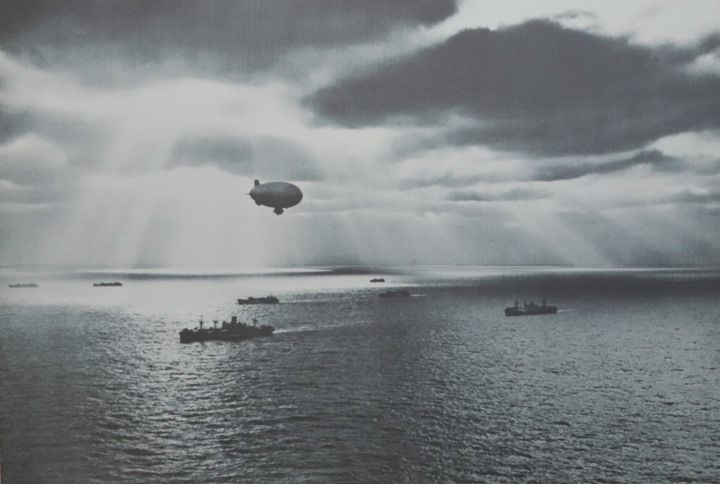
This photo shows a Goodyear-built airship as
it keeps
watch over a convoy heading to England with important war products
and food. Airships were one of the many weapons used to combat the
German U-Boat menace during World War Two.
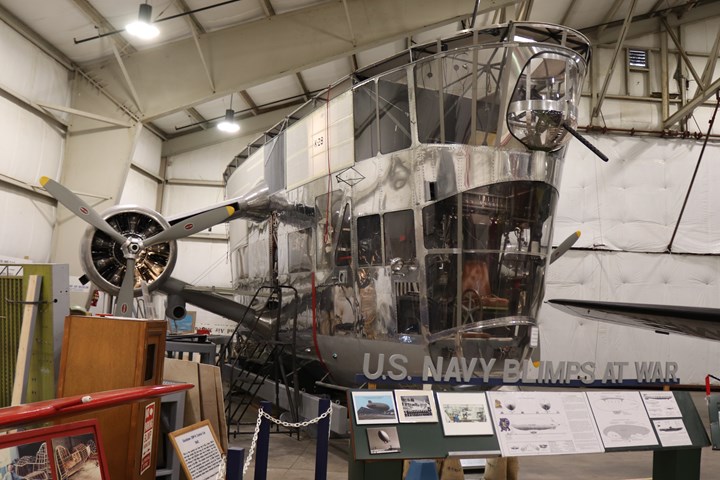
The next series of photos show more of
K-28's restored crew cabin at the New England Air Museum. Author's
photo.

Author's photo.
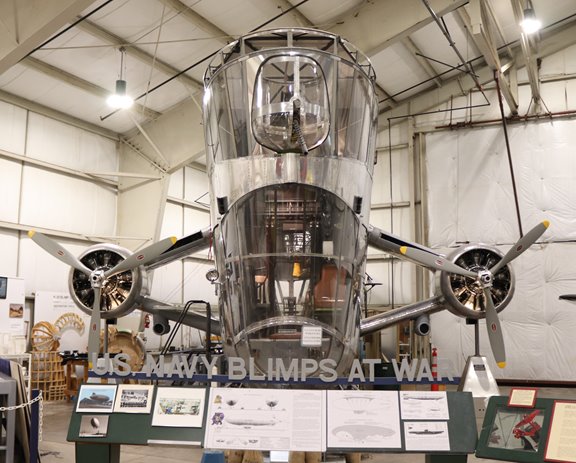
Author's photo.
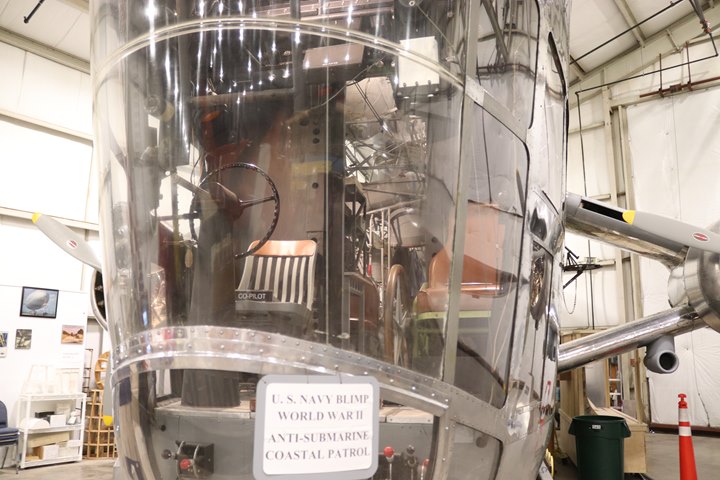
Author's photo.
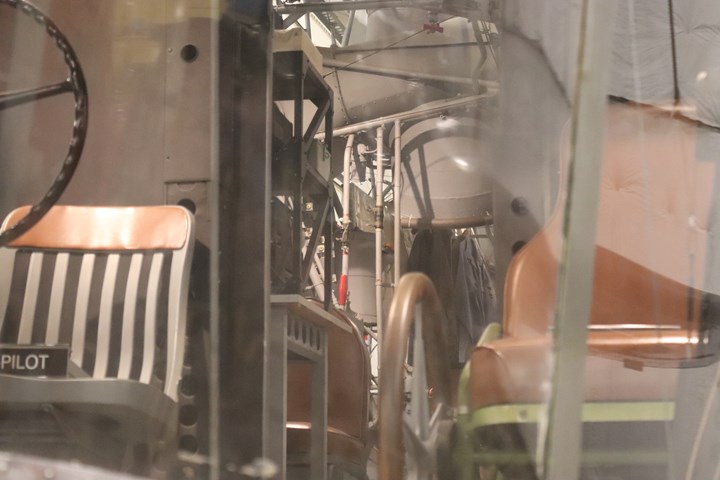
The pilot controlled pitch and altitude
while the co-pilot controlled the course. Author's photo.
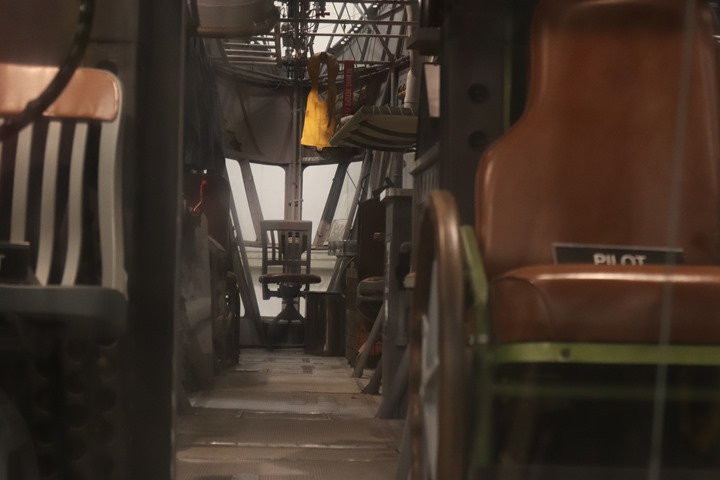
The co-pilot and rear observer had
office-type chairs. Author's photo.
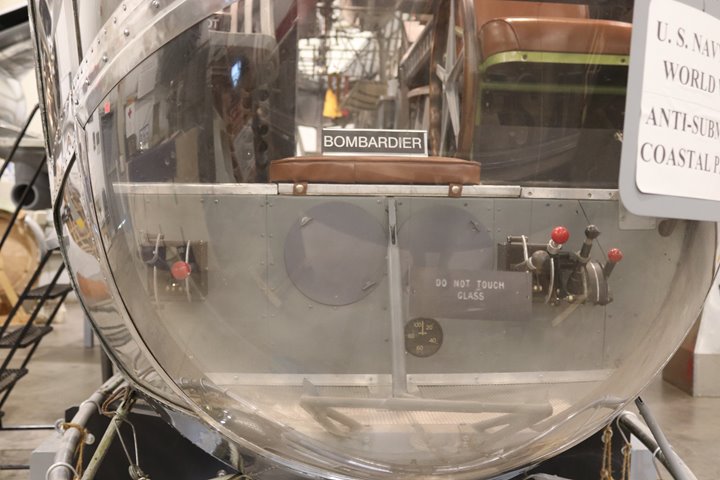
The bombardier laid down at his position to
drop bombs or depth charges. Author's photo.
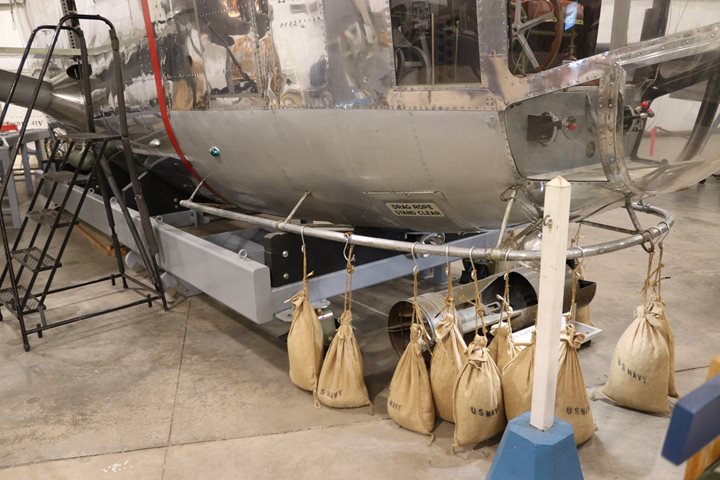
The airships used sandbags to assist in
keeping them on the ground when not in operation. Author's photo.
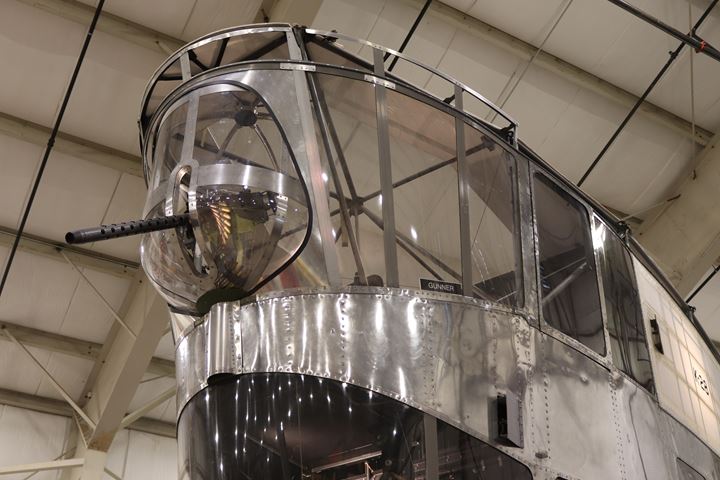
A .30 caliber machine gun was mounted in the
nose for self-defense. Author's photo.
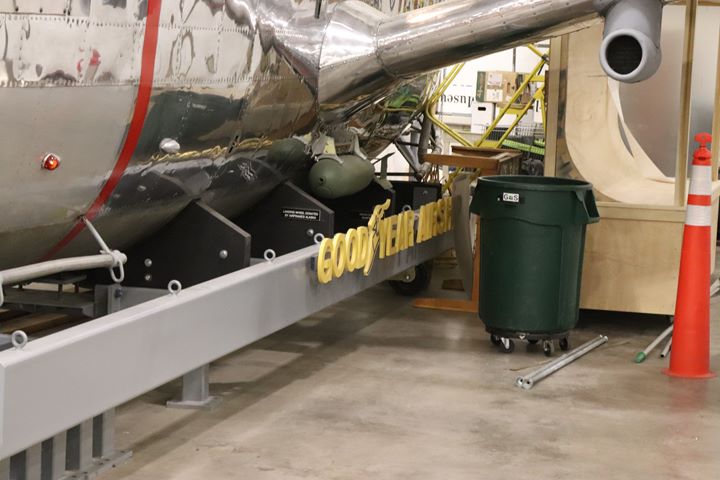
Author's photo.
Goodyear Aircraft Corporation, Akron, OH:
The following aircraft and aircraft components were produced in Akron.
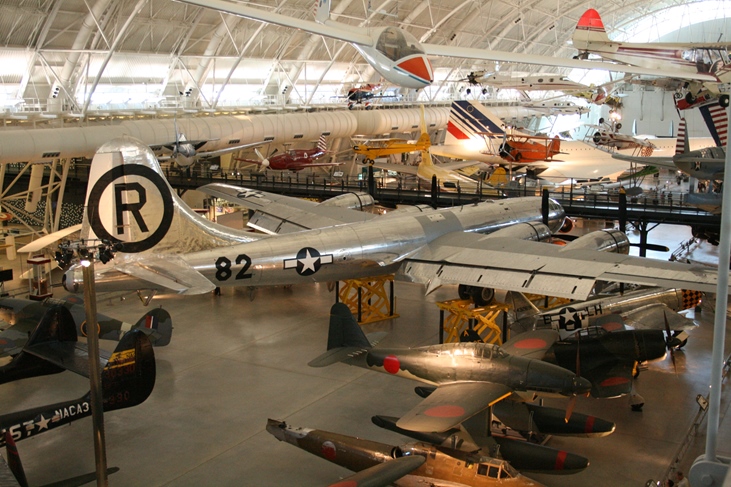
Beginning in May 1944, and extending through
September 1945, Goodyear provided 531 each of the following airframe
components to Glenn L. Martin B-29 plant in Omaha, NE. These were
the forward and rear bomb bay fuselage sections, rudders, vertical
stabilizers, dorsal fin assemblies, elevator assemblies, and horizontal
stabilizer assemblies. Author's photo.
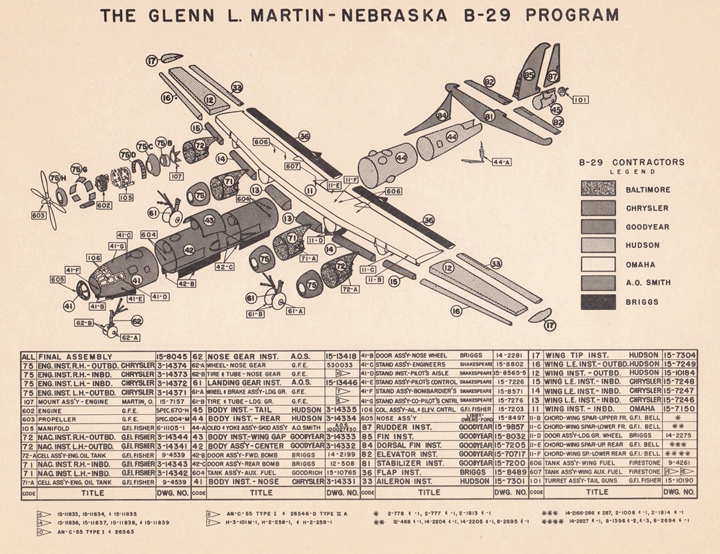
This primary document from the Glenn Martin
plant in Nebraska shows the fuselage and aircraft control surfaces
Goodyear manufactured for the B-29 program. The B-29 was the most
expensive project undertaken by the United States during World War Two.
It was even more expensive than the Manhattan Project.

As the Martin information from World War Two shows,
the US auto industry was the major supplier of airframe and structural
components to Omaha.
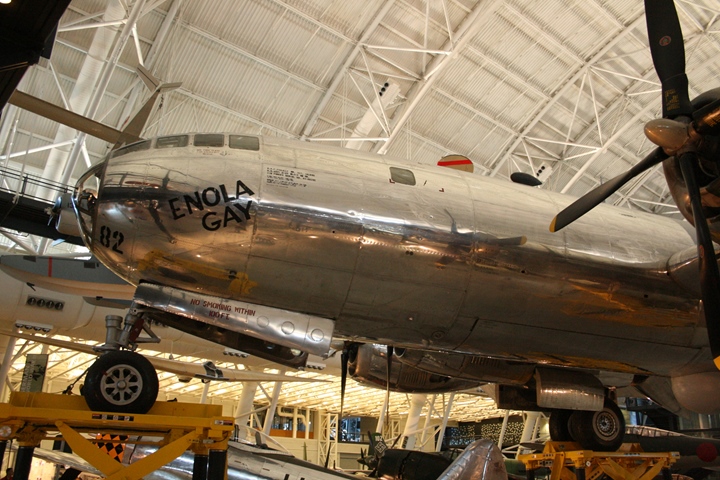
The front fuselage section was built by
Chrysler. Goodyear built the front bomb bay fuselage section, starting at the seam just forward of the propeller. The
Goodyear-built rear bomb bay fuselage section is adjacent to the wings. Author's photo.
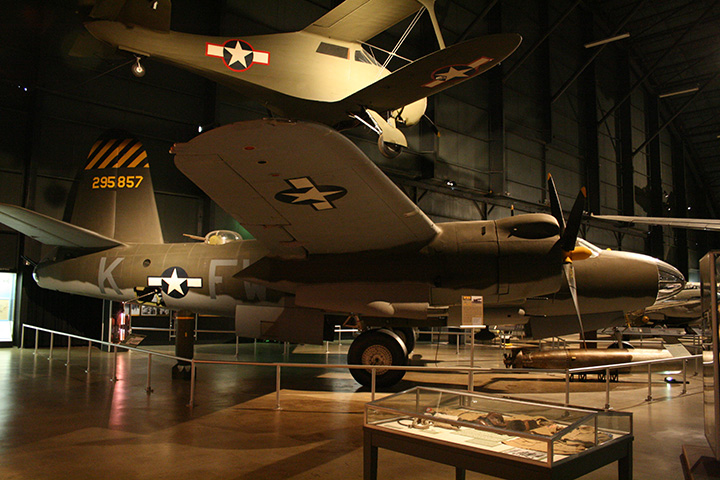
Goodyear built outer wing sections for the Martin B-26
like this one on display at the National Museum
of the United States Air Force Dayton, OH. Author's photo.
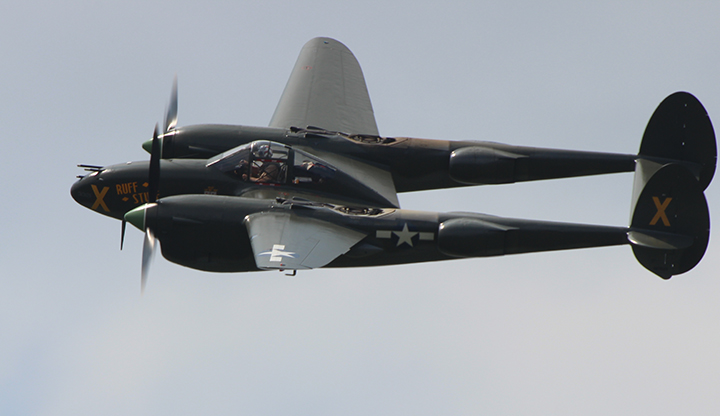
Goodyear produced control surfaces for the
Lockheed P-38. Author's photo.
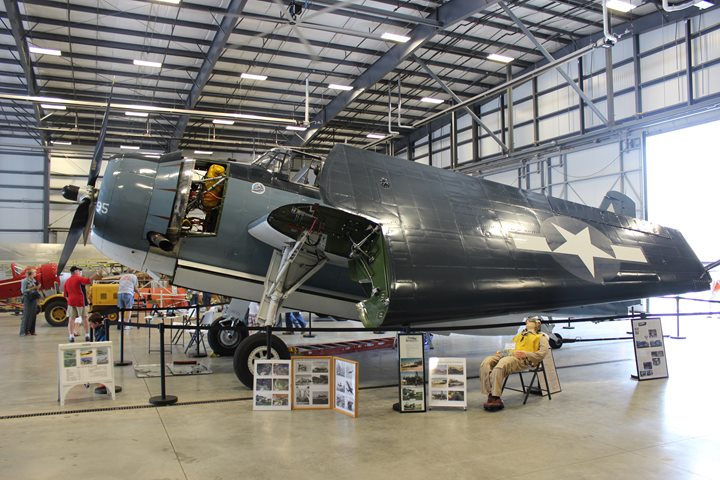
The Grumman TBM had Goodyear assemblies in
it. Author's photo taken at
the Liberty Aviation Museum.
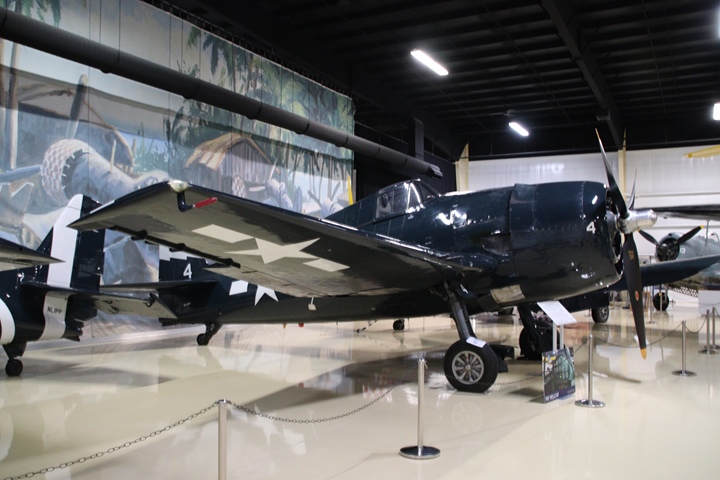
Goodyear also produced control surfaces for
the Grumman F6F Hellcat. The Grumman F6F shot down more Japanese
aircraft during World War Two than any other aircraft, operating
primarily from the Essex Class Aircraft Carriers. This example is
on display at the Kalamazoo Air Zoo Aviation Museum. Author's
photo.
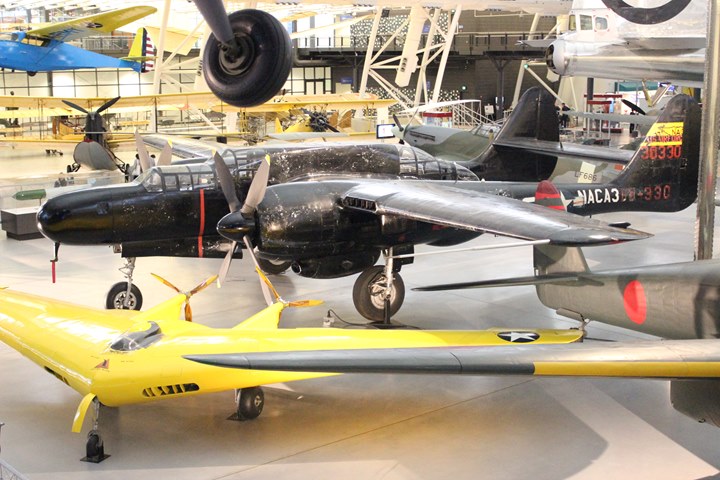
Goodyear built outer wing sections for the
Northrop P-61 Black Widow night fighter. This one is on display at the Udvar-Hazy
Center of the National Air and Space Museum. Author's photo.
Goodyear Aircraft Corporation,
Litchfield Park, AZ: The following aircraft components
were produced in Litchfield Park.

Consolidated Aircraft Corporation in San
Diego, CA produced 217 PB2Y Coronado flying boat patrol bombers.
Goodyear at Litchfield Park, AZ
produced the flight deck for the aircraft.
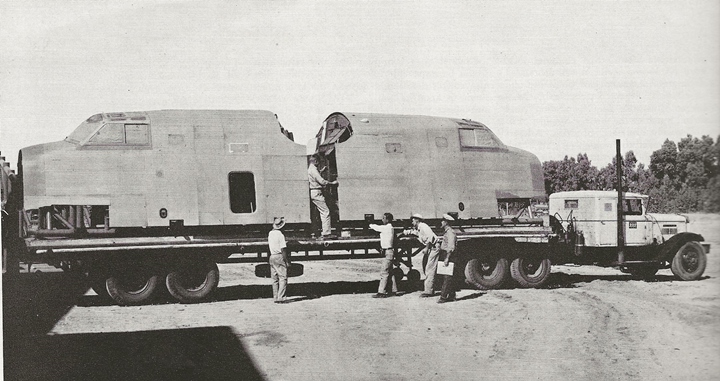
Two flight PB2Y decks are being loaded onto
a semi-trailer for shipment to San Diego during World War Two.
This was a complicated piece of the aircraft. In an
area that only had cotton farms and no heavy industry until the Goodyear
plant was built, this factory was an impressive accomplishment.
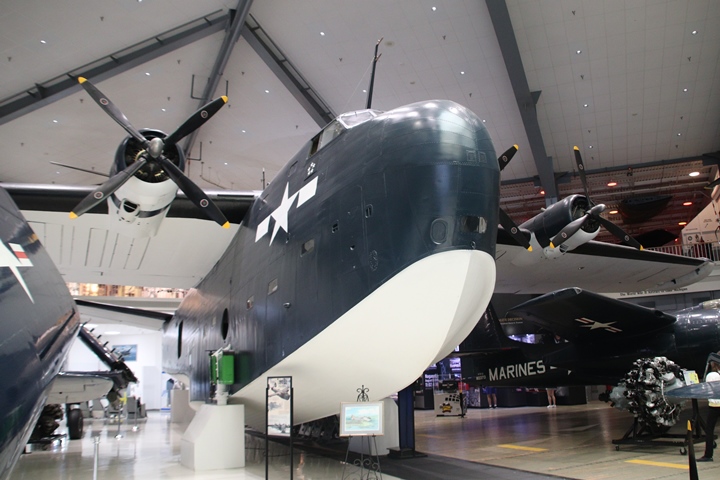
This is the only surviving example of the
217 PB2Y Coronados that were built. This particular aircraft was
converted into an admiral's transport aircraft and flew Admiral Nimitz
to the signing of the Japanese surrender ceremony in Tokyo Bay on
September 2, 1945. Admiral Nimitz and his staff were able to land
in Tokyo Bay and then be transported by small boat the USS Missouri.
Author's photo.

Author's photo.

Author's photo.
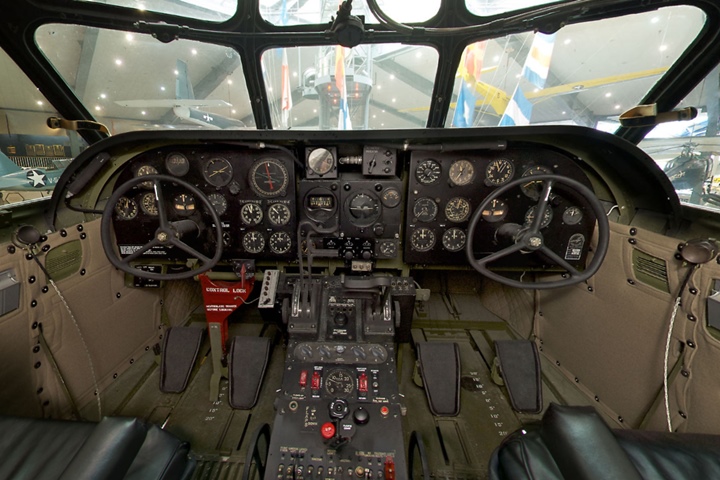
This view shows the flight deck built by
Goodyear in Litchfield Park, AZ. Photo courtesy of the National
Naval Aviation Museum.
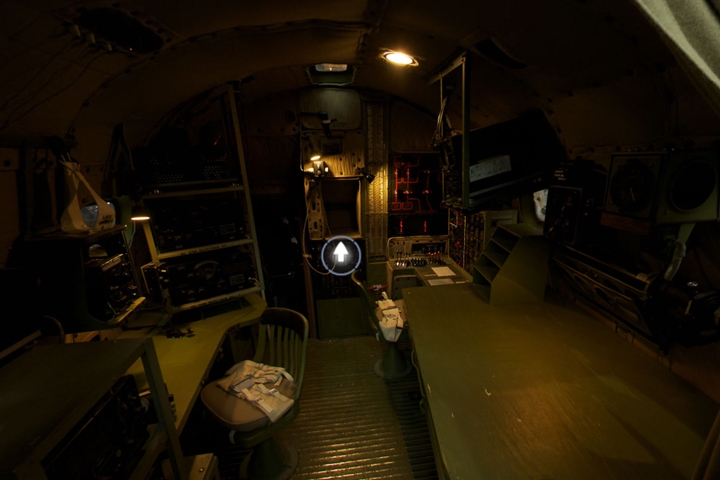
The radio operator and navigator were
located on the flight deck behind the pilot and co-pilot.
Photo courtesy of the National Naval Aviation Museum.
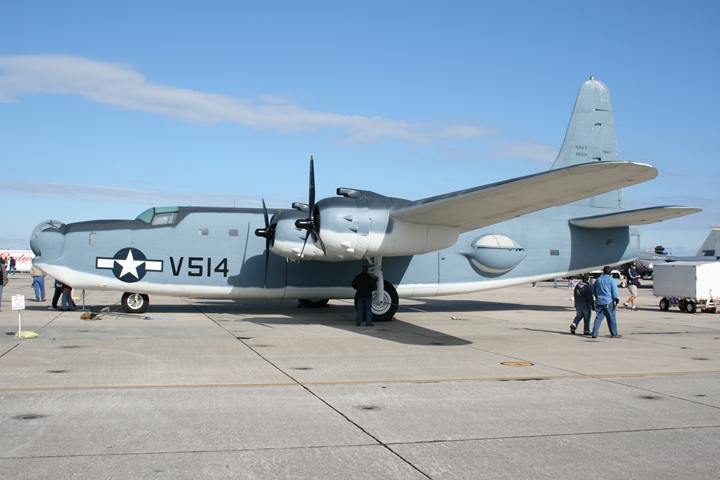
The Goodyear Litchfield Park, AZ facility
produced wing panels, control surfaces, and empennages for the 739 PB4Y
aircraft built. Author's photo.
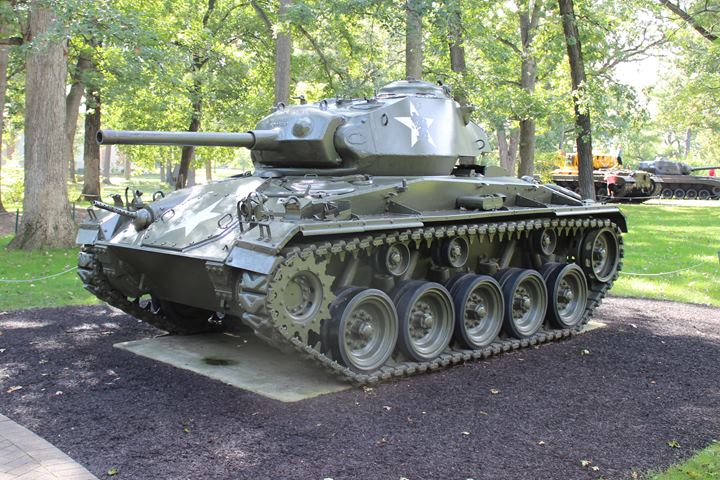
Goodyear produced the rubber tires for the
M24 Chaffee light tank. Author's photo.
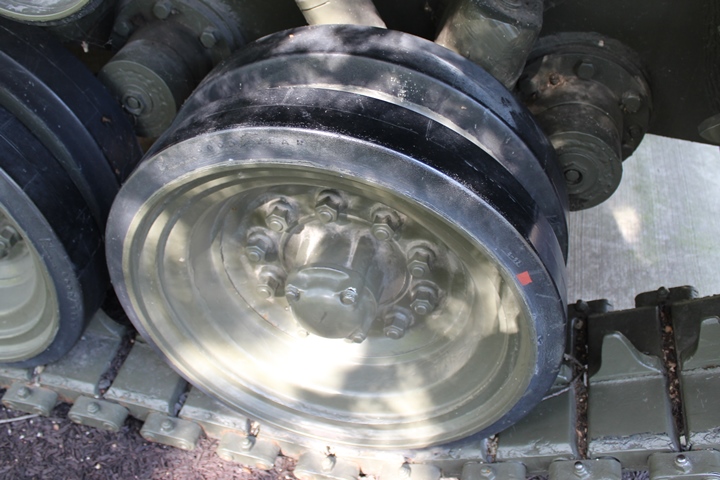
Author's photo.
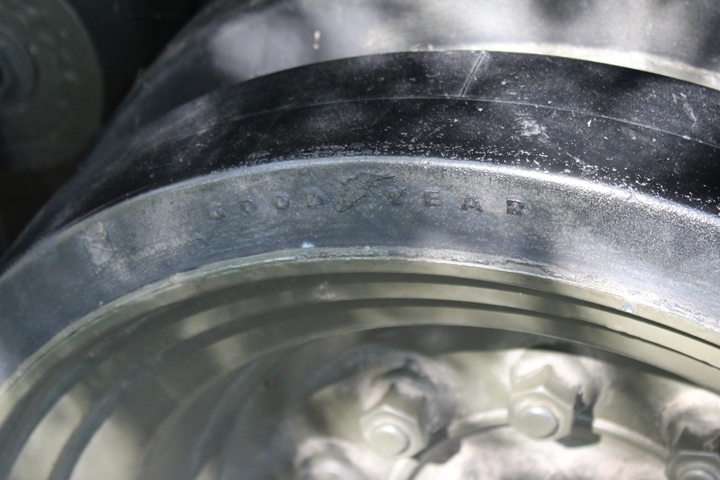
Author's photo.
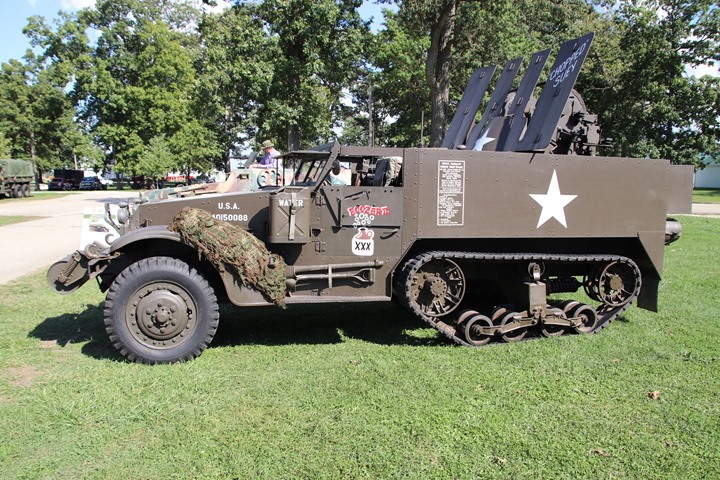
Goodyear produced 31,651 halftrack tracks. Author's photo.
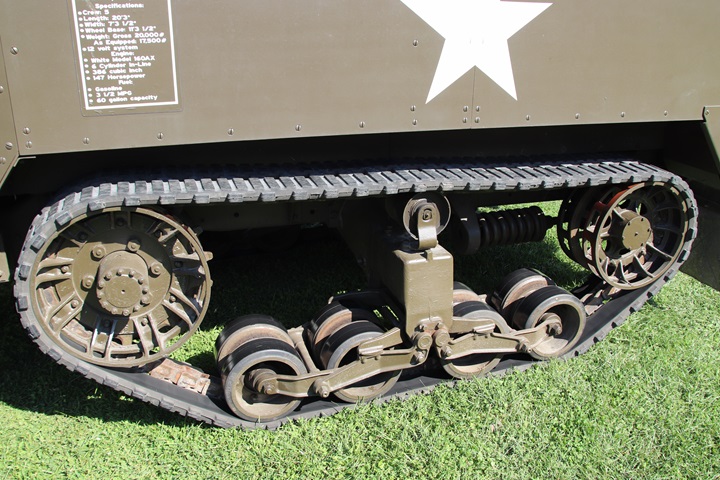
The tracks were constructed with a
continuous steel rope over-molded with rubber. Author's photo.
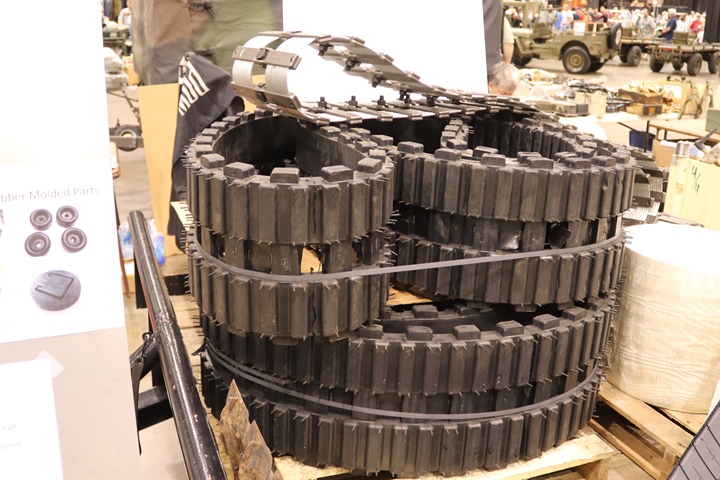
Shown here are new tracks that can be purchased to replace worn tracks
on restored half-tracks. Author's photo.
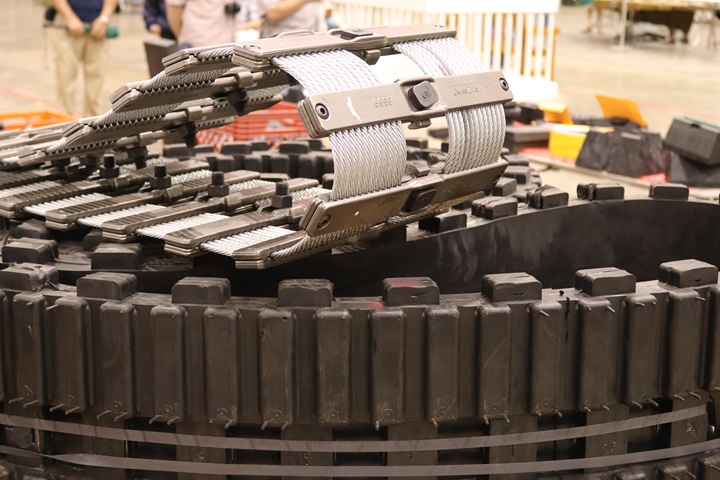
This photo shows the two continuous steel
ropes that are joined together with steel brackets and fasteners.
Author's photo.
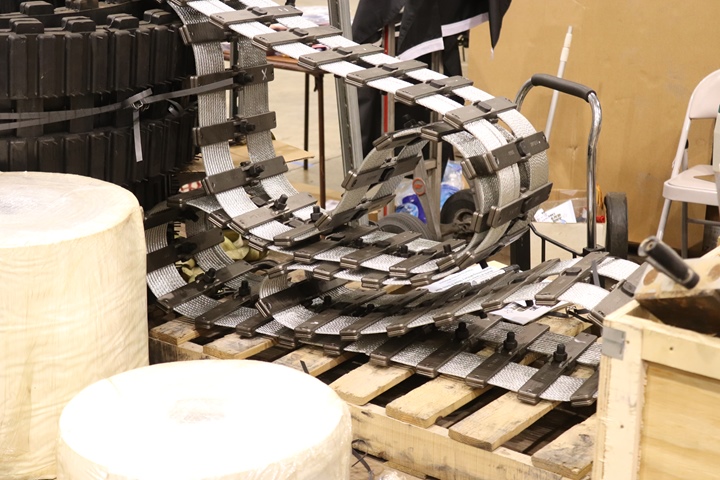
Author's photo.
Goodyear Plants-Akron, OH: During
World War Two Goodyear had plants on the east side of Akron, at the
municipal airport on the southeast side of town, and east of town at
Wingfoot Lake.
Eastside Complex:
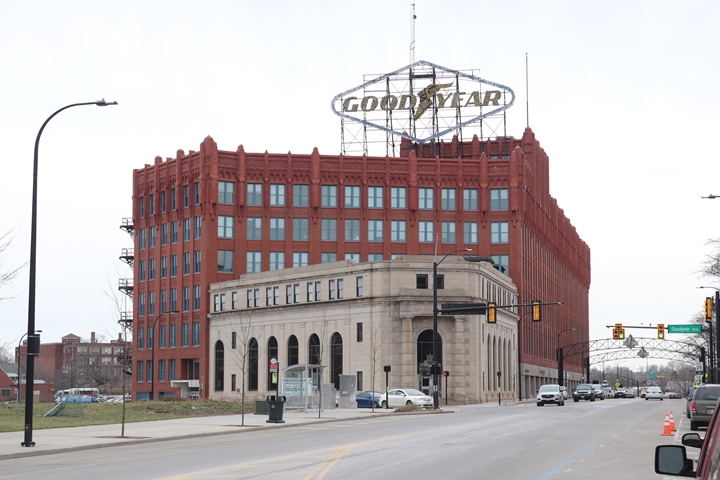
The six story red-brick building is the
former headquarters of Goodyear. The Goodyear sign still remains even
though the headquarters is a mile south of this location on Innovation
Way. The gray triangular shaped building in front of it is a bank.
This view is looking southeast down Market Street. Author's photo.
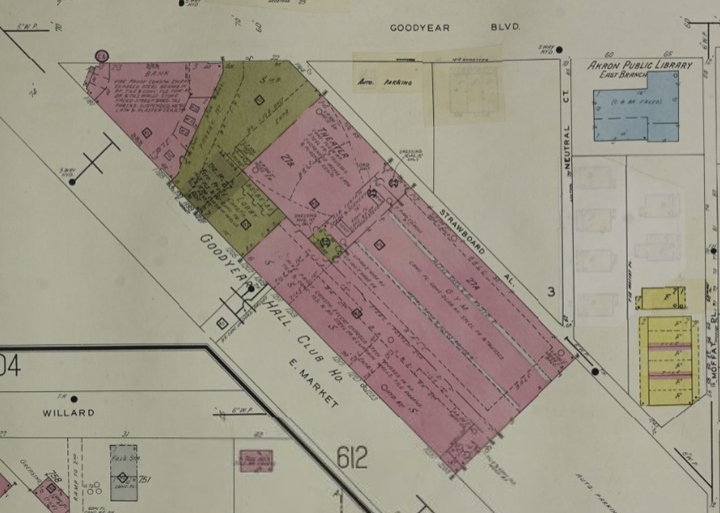
This 1951 Sanborn fire map shows the building
as it would have been during World War Two. The headquarters building
had a theater and employee gymnasium. The library is still there,
and I was able to do some Goodyear research there when I visited Akron.
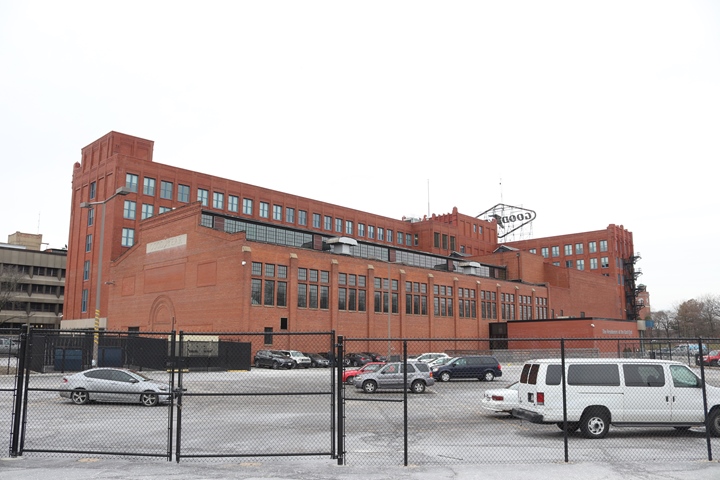
This is the southeast section of the
Goodyear headquarters building. The company's employee gymnasium
is on the east side of the building. The theater is at the far end of the
building where there are no windows. Author's
photo.
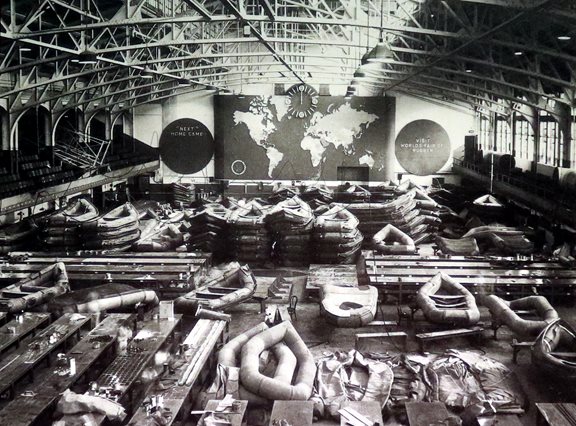
During World War Two aircraft rubber assault
boats and life rafts were assembled in the gymnasium.
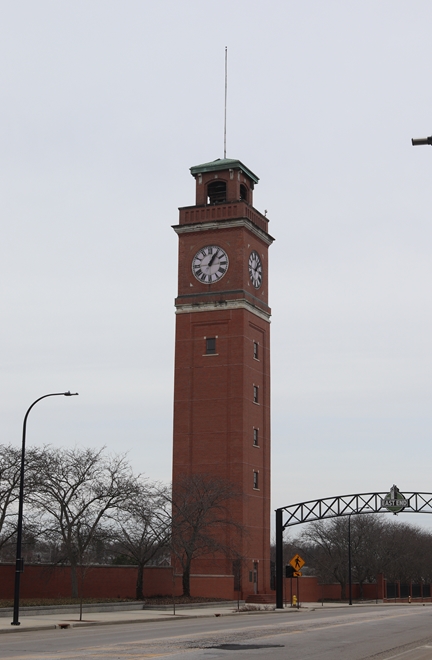
The Goodyear clock tower is north of the
former Goodyear headquarters and on the opposite side of Market
Street. Some of the
former Goodyear manufacturing plant in Akron was located behind the
brick wall. Author's photo.

This Sanborn map shows the massive Goodyear
manufacturing plant across Market Street from the former headquarters
building.
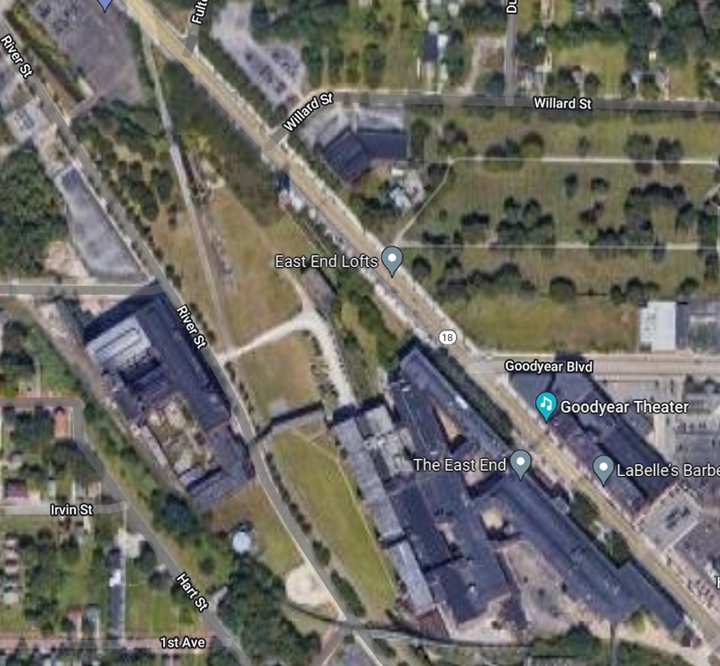
A current Google Maps satellite view shows
that about 50% of the former Goodyear manufacturing plant still stands.
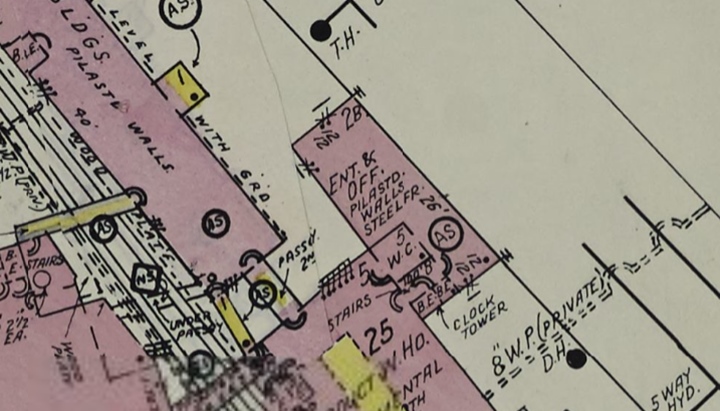
This enlargement of the Sanborn map shows
the clock tower.
Akron Municipal Airport Complex:
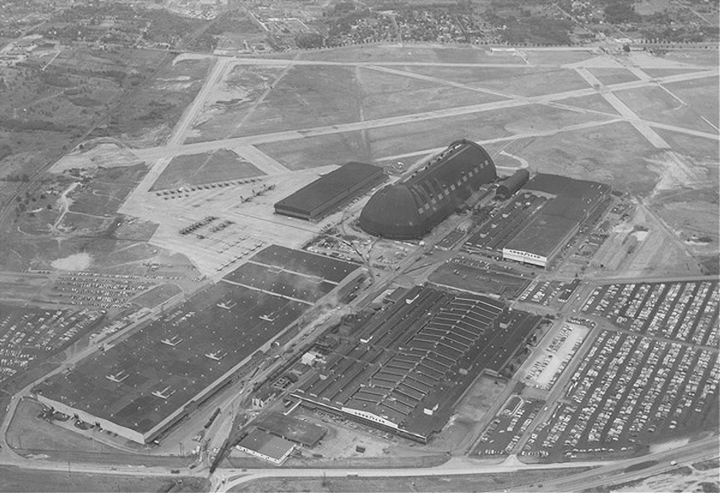
In 1942 there were 32,000 persons working at
this facility making a variety of aviation products. The products
included: FG-1 Corsairs,
F2Gs, airships, B-26 outer wings, B-29 fuselages and empennage
assemblies, P-61 outer wings and empennage assemblies, aircraft
wheels, aircraft brakes, assemblies for B-32, assemblies for TBF, P-38 control
surfaces, and F6F control surfaces.
There were 531 B-29 bomb bay fuselage
sections and 4,001 FG-1 Corsairs built at this facility along with all
of the other aircraft components.
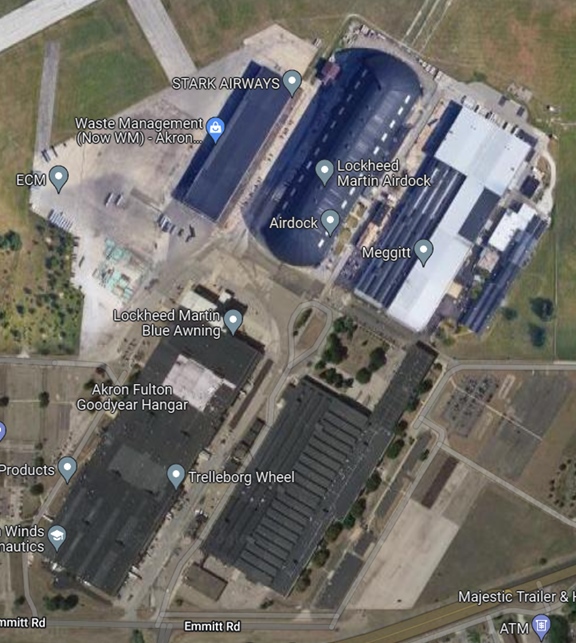
This Google Maps satellite view shows the
former Goodyear Aircraft Corporation complex as it is today.
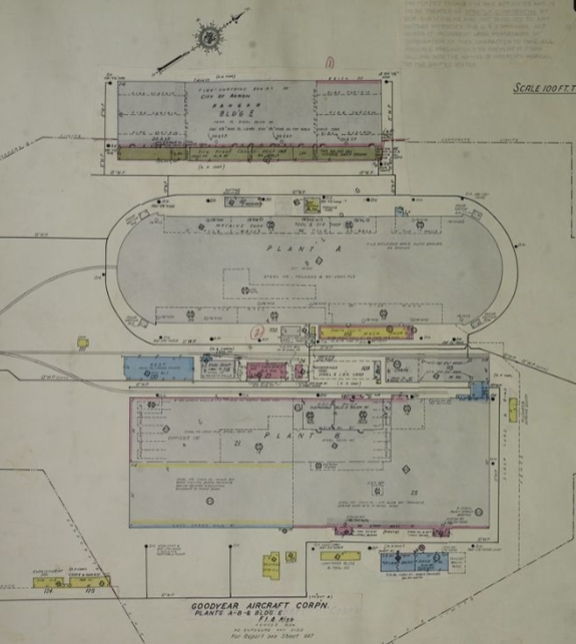
The building in the middle is the Airdock.
Today the Airdock and building at the bottom of the map is owned by
Lockheed-Martin and the top building is owned by Waste Management.
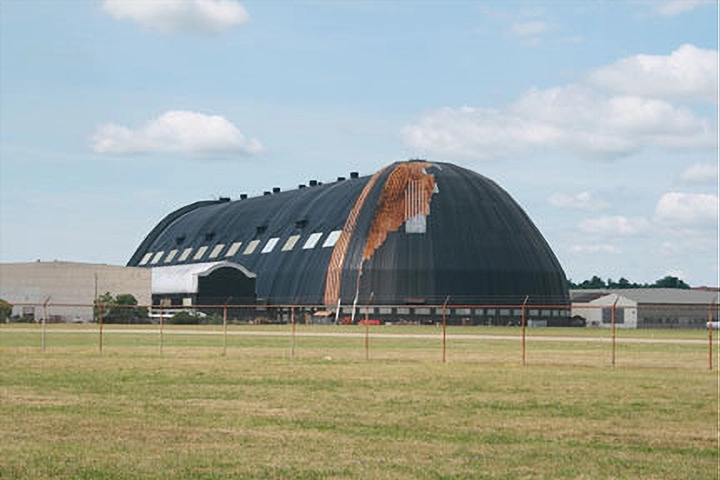
This photo was taken several years ago after
the Airdock had caught on fire from a lightning strike. The Akron
Fire Department was able to extinguish the fire and save this historical
building. Author's photo.
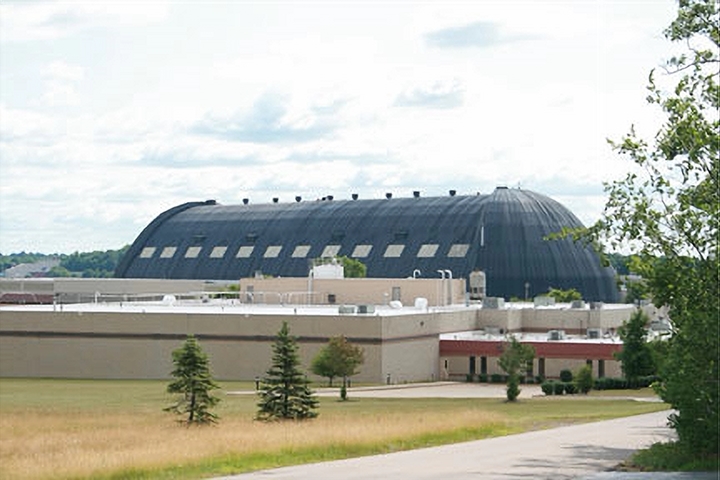
This photo was taken after the repairs were
made to the building. Author's photo.
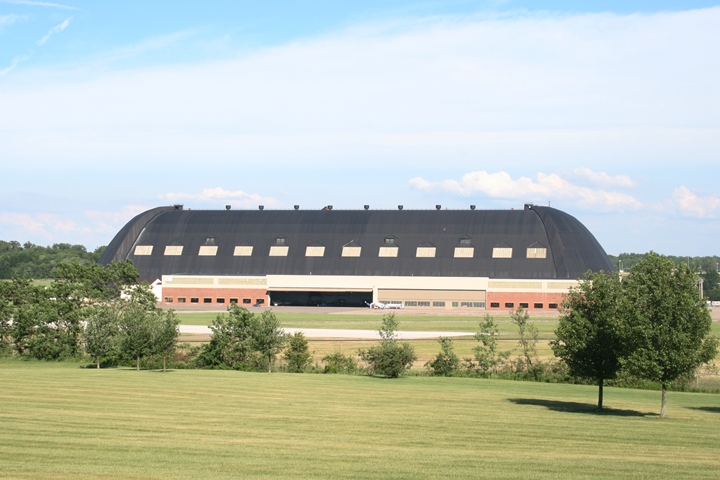
Author's photo.

After World War Two, the U.S. Navy had a
Naval Air Reserve Station at the Akron Municipal Airport. The 1951
Sanborn map reflects this. During World War Two, Goodyear used the
building for production. Today there are several occupants in the
facility.
Wing Foot Lake: This is the
operating base for the Goodyear blimp. During World War Two, it
engaged in the manufacture and testing for the Navy airships.
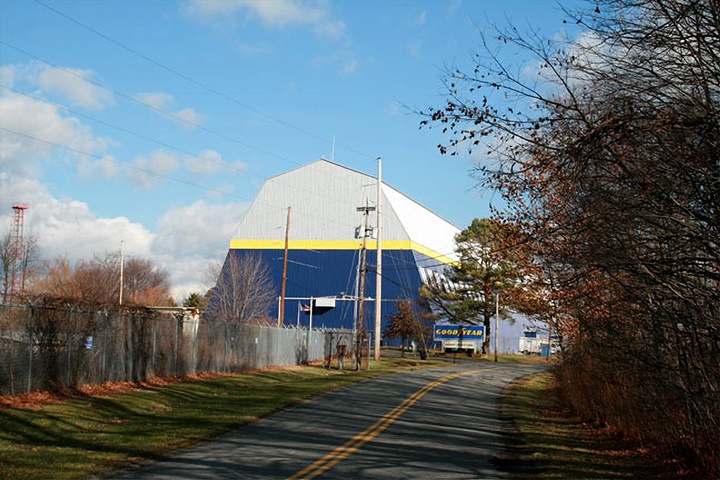
Author's photo.
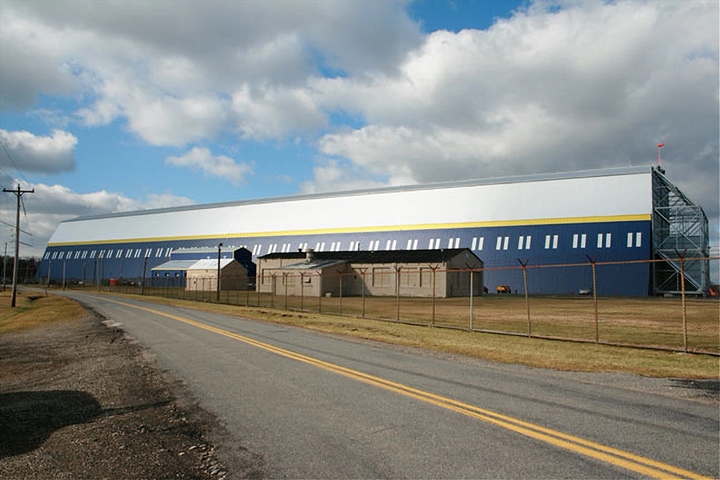
Author's photo.
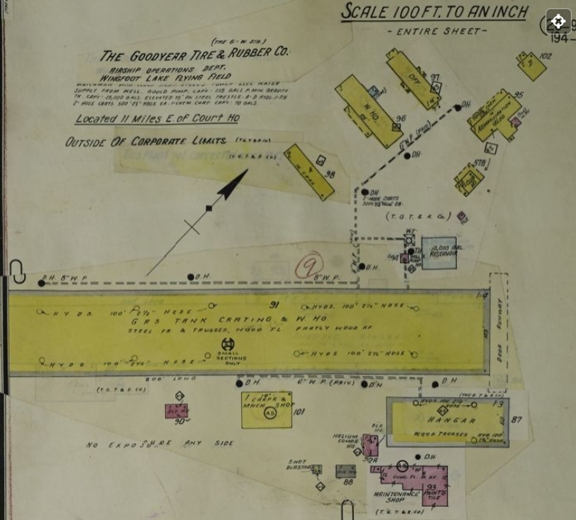
The Sanborn map shows several buildings in 1951 that the Google Satellite view below shows are now
gone.
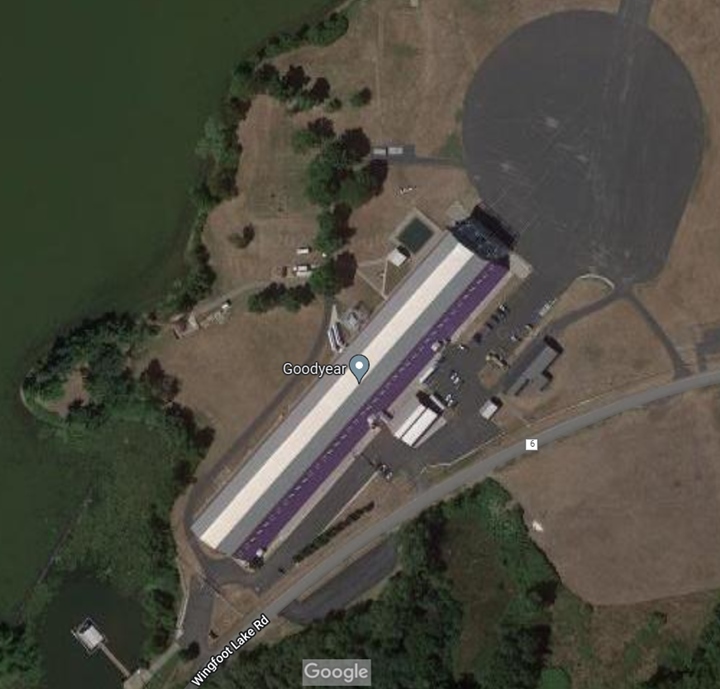
Goodyear Plant - Litchfield Park, AZ:
In 1916, Goodyear executive Paul Litchfield came to the Phoenix
area to find local cotton farmers to provide cotton required for the
cord in the company's tires. When he found the farmers were not
interested, he suggested to company management that Goodyear purchase
farms and produce the cotton for its own use. So, Goodyear Farms
came into being and Goodyear had a large presence in the area twenty
miles west of Phoenix. As World War Two approached, the U.S. Navy
came to Paul Litchfield, now chairman and CEO of Goodyear, and requested
the company build and operate a new Navy-owned aircraft manufacturing
plant in the same area as its cotton farms. In August 1941,
construction began on the new facility.
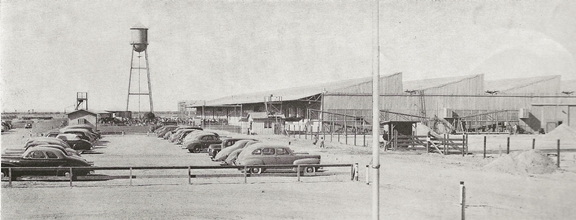
This World War Two-era photo shows the south
end of the plant and the water tower at the west end of the facility.
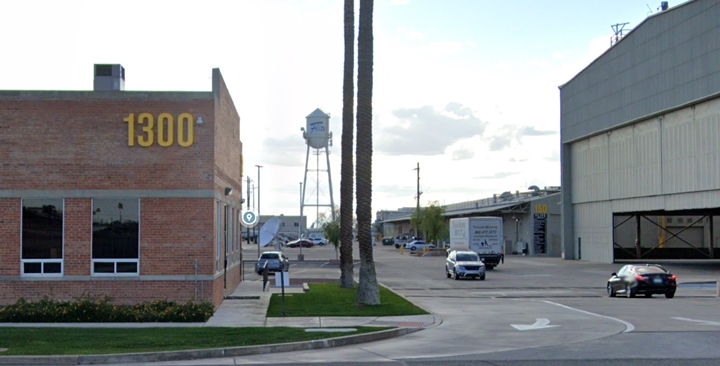
This current Google Maps street view shows
the water tower and the south end of the original plant. There
have been expansions and much growth in the area in the past 80 years.

This section of the Google Satellite view
shows the same area with the water tower at the left of the photo.
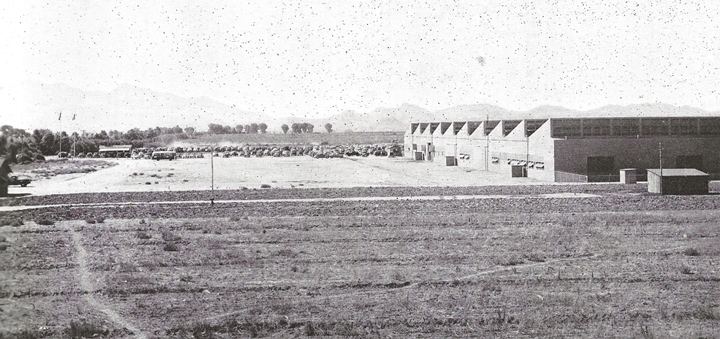
This view is to the south.
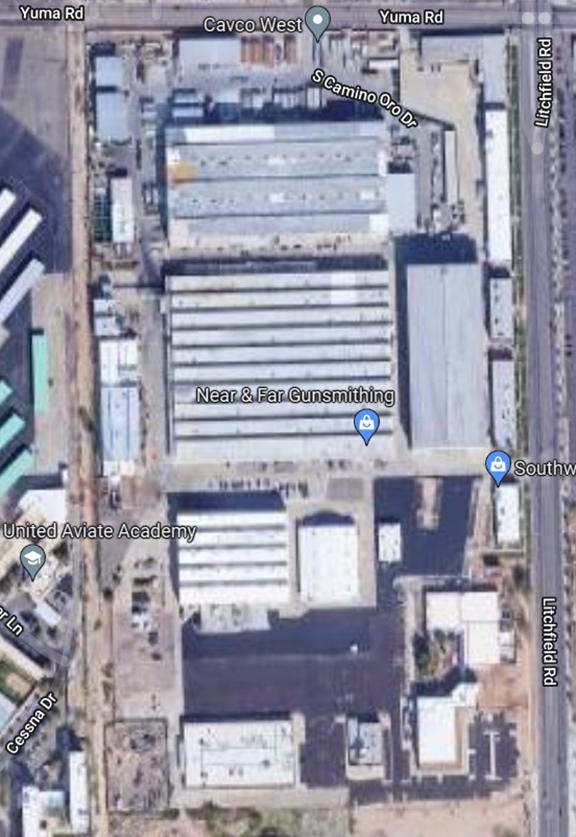
This view shows how the plant grew after
World War Two and what it currently looks like. Goodyear no longer
has a presence here.
|








































































